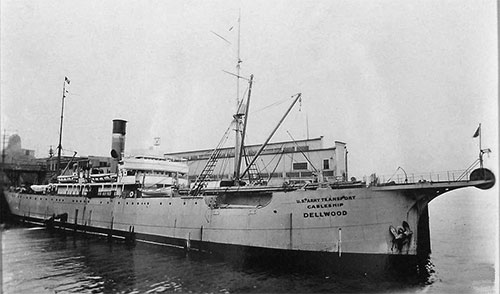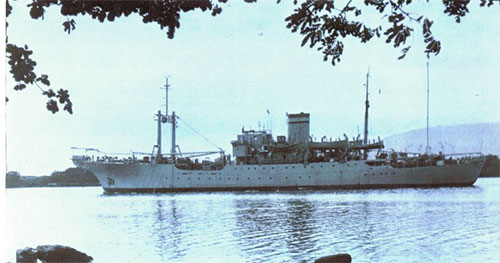Connecting Ketchikan to the Outside worldRecent KPU submarine cable latest in a century of 'cables'By DAVE KIFFER February 28, 2021
In October of 2020, Ketchikan Public Utilities completed a 90-mile submarine cable with Prince Rupert in order to speed up communications, just the latest in a series of steps that began long before Alaska was a state. "The 2020 project is about guaranteeing Ketchikan access to affordable high speed broadband internet," KPU telecom director Ed Cushing said recently. "Over the past 25 years broadband/internet and wireless phones have completely displaced "long distance" as the manner in which we communicate." Cushing said that the community was part of two previ0us important "connection" projects, in 1924 and 1956. "The 1924 project was to enable the Army, government, business and citizens to send telegrams to communities in Alaska," he said. "As a practical matter, telegrams consisted of a few sentences - most lengthy correspondence was (still) by US Mail and took weeks to arrive." Sending or receiving a telegram required going down to the local Army Communications Service (ACS) building and standing in line, he added. The 1956 project was to provide "a few dozen long distance circuits," Cushing said. "Making a long-distance call required dialing 'O' and asking an operator to place a call for you," he said. "For many years after the new cable was placed, the cost of making a long distance remained cost-prohibitive for most families and business. Most routine business was still conducted by the US Mail." Cushing said that - prior to the October connection - KPU was dependent upon renting broad band space from commercial providers, but now has its own cable to the Outside world with nearly unlimited space for expansion. That, of course, is now. It was a whole different world back when. The first efforts to connect Alaska - then a territory - were made by the US Army Signal Corps, beginning in 1900. The history of the "Alaskan Cable System" was recorded by the Signal Corps in a 1925 report to Congress. The first cable was laid between Fort Saint Michael and Safety Harbor and eventually connected to Fort Davis in Nome in October of 1900. The next year, 1901, cable was laid between Skagway and the new territorial capital in Juneau. The original plan was hook up as many Alaskan military posts as possible. In order to connect with the Outside world, the cables then went on Canadian lines. During these years, the US and British governments were locked in a tense stand-off on drawing up the border between Southeast Alaska and British Columbia and the US Secretary of War Elihu Root advocated for a submarine cable to be built from the "northwest coast of the State of Washington to the southern point of our Alaskan Territory." What he called an "all Alaskan route." As a result, nearly one million dollars was appropriated to build a cable from Fort Lawton near Seattle to Sitka and Juneau and eventually on to Fort Liscum near Valdez. It was completed in October of 1904, by the cable ship "Burnside." Eventually that cable was extended to Seward. The cable remained in operation for the next two decades, but by the early 1920s, it was clear that the volume of traffic was too great for the original cable. The Signal Corps purchased a new vessel, the steamship Dellwood, and converted it into a cable layer. The cost of the replacement cable was set at $1.5 million. Originally, the Corps had hoped to purchase cable made in the United States for the 1,900-mile-long project. But when the bids were opened, in 1923, the only companies that bid were British.
In the meantime, the US Navy destroyers Hull and Corry had surveyed a route from Seattle to Ketchikan using sonic depth finders, via Trocadero Portage, and from Ketchikan to Seward. Cable laying operations began on May 11, 1924 and the Dellwood reached Ketchikan on May 30. The section between Ketchikan and Seward was completed between September 27 and October 9 of 1924. The 1925 Signal Corps report naturally boasted of the changes the new cable had brought to the territory. "Isolation, the bane of any newly settled country, no longer holds Alaska in its grip, and the hopes, ambitions and achievements of its inhabitants are firmly bound to those of the people of the United States and to those of the rest of the world," the report concluded. " It is not difficult to realize that the cable has had an important share in the development of the territory, both socially and commercially." The Signal Corps also noted in its report that it was up to Congress to commit to spending $140,000 a year to keep the cable operating. And it did, through the Depression and the years of World War II, when communications in Alaska became even more critical do the expansion of the military presence and the effort to drive the Japanese out of the Aleutian Islands. But, once again, the increasing needs of technology caused a reevaluation of the cable connection in the 1950s. In the post Korean War period, military connections to Alaska had to be improved as the United States and the Soviet Union were settling into the "Cold War" that would last for the next four decades. In 1954, AT&T announced plans for an $14 million, 800-mile underwater telephone system that would connect Port Angeles and Ketchikan and would hook up with a 370-mile cable already under construction by ACS between Skagway and Ketchikan. The plan was for the cable to be operational by 1956 and "provide, both public and defense purposes, a speedier and more reliable means of telephone communication between Alaska and the United States proper" according to a 1954 report by AT&T. At the same time, AT&T and the Canadian and British governments were also working on the first transatlantic telephone cable between Newfoundland and Scotland. "The Seattle-Ketchikan submarine cable will be similar in design to the transatlantic system," AT&T noted. "It will consist of two deep-sea submarine cables several miles apart, one for northbound transmission and the other for southbound transmission." The Alaska link would have 36 message circuits, a significant increase over the 13 circuits on the 1924 link. In 1957, AT&T produced a 10-minute, mini-documentary "Link to the North" on the laying of the cable between Port Angeles and Ketchikan, which was accomplished by the cable ship, the Albert J. Myer, between June and August of 1956.
More than 11 million pounds of cable was used to connect Ketchikan and Port Angeles, the two lines running outside of Vancouver Island and the Queen Charlotte Islands (Haida Gwaii) and eventually going on land at the southern tip of Dall Island, west of Prince of Wales Island. Then the cable continued through northern Dixon Entrance and up Revilla Channel to Ketchikan. Operations began on June 11. The cable - made of steel, copper, plastic and jute - was released at the speed of the ship, six knots. The ship stayed on course by triangulating radio signals from three locations, Cape Scott, Marble Island and Cleft Rock. Cape Scott (northern Vancouver Island) and Marble Island (off the northwest coast of Prince of Wales Island) are easy to find on modern maps. But Cleft Rock is a little harder to locate. It appears to be on a small island in Security Bay on Kuiu island southwest of Kake. In all three locations, several hundred foot high radio towers were built and manned to provide 24-hour a day radio signals for the project.
The process went fairly smoothly until the ship reached Dall Island where the cross-island cable had already been laid. The Myer was able to connect up the end of the existing cable via a bouy off the west end of the island but when it went around to the east end of Dall Island there was no buoy to be found. A storm had separated the buoy and pushed it on shore. That meant the cable connection was several hundred feet down at the bottom of the ocean. The crew had to engage in a fairly low-tech "jigging" operation to find the end of the cable, bring it to the surface and connect it to the cable on the ship. After that was completed the rest of the cable was spooled out and connected to facilities in Ketchikan. The ship arrived in Ketchikan on July 11. Then the ship repeated the operation in reverse to put in the second cable. It took a few months to work all the bugs out of the system, but on Dec. 11, 1956, the first official call was made from Washington DC - 4,600 miles away - to Juneau between Assistant Secretary of the Interior Hatfield Chilson and Alaska Territorial Governor B. Frank Heintzlman. Alaska, according to the 1957 documentary, was now "only a breath away" from communicating with the Outside world.
On the Web:
Contact Dave at dave@sitnews.us Dave Kiffer ©2021 Publication fee required. © Representations of fact and opinions in comments posted are solely those of the individual posters and do not represent the opinions of Sitnews.
|
||||||





